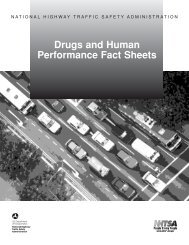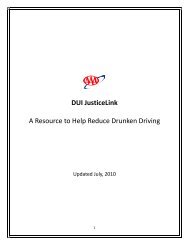2007 National Roadside Survey of Alcohol and Drug Use by Drivers
2007 National Roadside Survey of Alcohol and Drug Use by Drivers
2007 National Roadside Survey of Alcohol and Drug Use by Drivers
You also want an ePaper? Increase the reach of your titles
YUMPU automatically turns print PDFs into web optimized ePapers that Google loves.
<strong>2007</strong> <strong>National</strong> <strong>Roadside</strong> <strong>Survey</strong> <strong>of</strong> <strong>Alcohol</strong> <strong>and</strong> <strong>Drug</strong> <strong>Use</strong> <strong>by</strong> <strong>Drivers</strong>: <strong>Drug</strong> ResultsIntroductionThis report presents prevalence estimates for drug-involved driving obtained from the <strong>2007</strong><strong>National</strong> <strong>Roadside</strong> <strong>Survey</strong> <strong>of</strong> alcohol- <strong>and</strong> drug-involved driving. Though national roadsidesurveys <strong>of</strong> alcohol-involved driving have been conducted on a decennial basis since the mid-1970s, this is the first U.S. national roadside survey where biological measures <strong>of</strong> drugs otherthan alcohol were obtained.BackgroundForty years ago, when the Department <strong>of</strong> Transportation (DOT) was established, it was wellunderstood that alcohol was an important factor in traffic crashes. In 1968, a new agency thatwas to become the <strong>National</strong> Highway Traffic Safety Administration (NHTSA) delivered itsReport to the Congress on <strong>Alcohol</strong> <strong>and</strong> Highway Safety, pointing to the need for improved dataon drinking <strong>and</strong> driving (USDOT, 1968). This need led to the establishment <strong>of</strong> incentives forStates to conduct blood alcohol concentration (BAC) tests on all fatally injured drivers <strong>and</strong>pedestrians, <strong>and</strong> eventually to the establishment <strong>of</strong> the Fatality Analysis Reporting System 5(FARS) in 1975. Initially, this data file was limited <strong>by</strong> the low level <strong>of</strong> testing for alcohol <strong>by</strong> theStates, but since 1982, through the use <strong>of</strong> an imputation system <strong>and</strong> increased testing <strong>by</strong> states, ithas provided a reliable means <strong>of</strong> assessing the Nation’s progress in reducing crashes in whichdrivers have been drinking. It is important to note, however, that FARS provides very limitedinformation related to drugs. While States routinely test drivers involved in fatal vehicle crashesfor alcohol, only a few also routinely test for other drugs. According to the Centers for DiseaseControl <strong>and</strong> Prevention, less than half <strong>of</strong> the fatalities in the 2005 FARS had drug test resultsavailable (CDC, 2006). In our review <strong>of</strong> the FARS data, we identified a lack <strong>of</strong> informationrelated to drug use.In addition to FARS, the national roadside survey (NRS) series estimates the prevalence <strong>of</strong>drinking <strong>and</strong> driving on weekends in the 48 contiguous States <strong>and</strong> assesses changes in prevalenceover time. The first NRS was conducted in 1973 (Wolfe, 1974), the second in 1986 (Lund &Wolfe, 1991), <strong>and</strong> the third in 1996 (Voas, Wells, Lestina, Williams, & Greene, 1998). Each <strong>of</strong>these surveys included a brief verbal survey <strong>and</strong> a breath sample to determine BAC. Together,the first three national surveys <strong>and</strong> FARS (1995) document reductions in the number <strong>of</strong> drinkingdrivers on U.S. roadways <strong>and</strong> alcohol-related fatalities over three decades. The fourth NRS,conducted in <strong>2007</strong>, followed the general methodology <strong>of</strong> the three prior surveys in obtainingBACs to enable comparison with the earlier surveys, but also incorporated several new features.These included questionnaires on drug <strong>and</strong> alcohol use disorders, <strong>and</strong> biological sampling <strong>of</strong> oralfluid <strong>and</strong> blood to determine the extent <strong>of</strong> the presence <strong>of</strong> drugs other than alcohol (i.e., illegal,prescription, <strong>and</strong> over-the-counter) among drivers.In 2005, NHTSA conducted a pilot study as a precursor to this full decennial <strong>2007</strong> NRS (Laceyet al., <strong>2007</strong>). The primary objective <strong>of</strong> the pilot study was to determine whether it was feasible tocollect data for drugs other than alcohol through oral fluid <strong>and</strong> blood samples. The pilot studyconsisted <strong>of</strong> six rounds <strong>of</strong> nighttime data collection, with over 800 drivers participating in thesurvey. Approximately 78 percent <strong>of</strong> the drivers participating in the survey agreed to provide an5 FARS was originally called the Fatal Accident Reporting System.9




